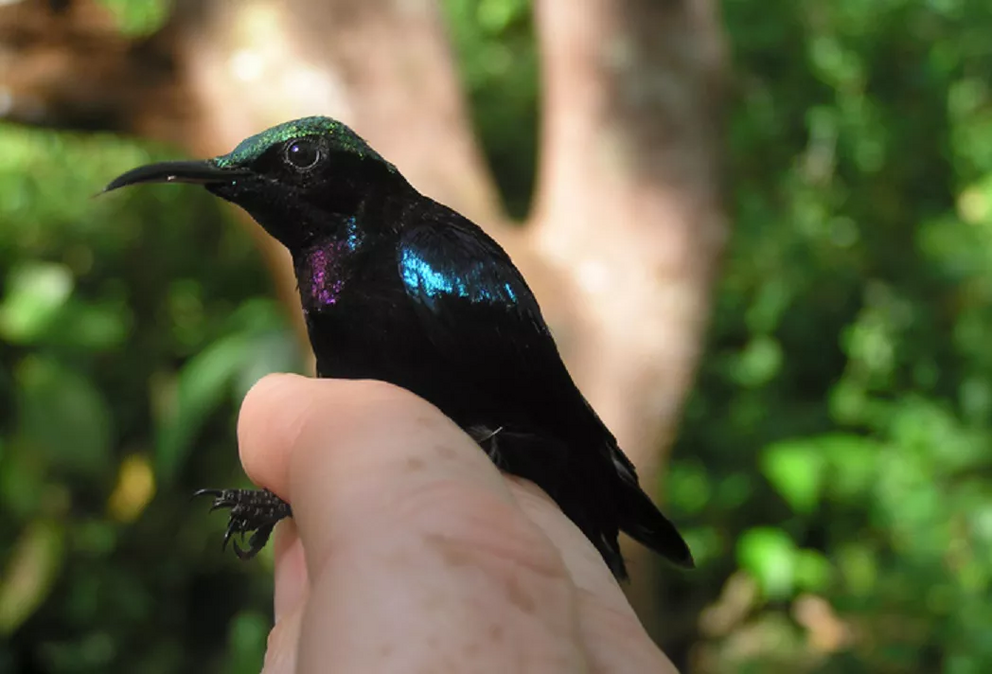Colorful new sunbirds discovered in Indonesia
Male Wakatobi sunbird.
Researchers identified them with DNA and by listening to their songs.
Several new species of tropical birds have been found on remote islands in Indonesia. Researchers have identified the Wakatobi sunbird, a new species that lives on the small Wakatobi Islands, located in central Indonesia. They also studied olive-backed sunbirds and black sunbirds and found that some of the birds they examined actually belonged to some previously unrecognized species.1
Sunbirds are similar to hummingbirds and play similar roles in the ecosystem. They have bright, curved bills and tubular tongues that allow them to reach down into a flower to feed on nectar. Sunbirds feed while perching, whereas hummingbirds feed while hovering.2
The new Wakatobi sunbird (Cinnyris infrenatus) looks similar to the olive-backed sunbird, but has darker feathers, shorter wings, and a higher-pitched song. Zoologists believe that because it has such short wings, it never spread beyond the tiny islands. The olive-backed sunbird, however, is able to fly long distances, so it was able to colonize other locations.3
These discoveries were part of a long-time collaboration between scientists at Trinity College Dublin and Universitas Halu Oleo in Sulawesi, Indonesia. They were working together for several years to explore the biodiversity and evolutionary changes of the region.
“Specifically, we became interested in the Wakatobi sunbird because of the work of Ernst Hartert, a German ornithologist active at the beginning of the 20th century,” Fionn Ó Marcaigh, first author on the paper and a Ph.D. candidate at Trinity College Dublin, tells Treehugger.
“He described the Wakatobi sunbird as a population with distinctive dark plumage, but he and the rest of the scientific community eventually decided that it was only a subspecies of the widespread olive-backed sunbird. We were keen to use modern methods to put this to the test.”
Analyzing DNA and Songs
 Male black sunbird.
Male black sunbird.
For their research, scientists used DNA, recordings of songs, and body measurement analysis to compare the sunbirds they studied.3
“We used a system called integrative taxonomy, which combines data on a number of aspects of the birds, including their song, plumage, and body morphology,” Ó Marcaigh says. “We recorded their songs using digital recorders, measured live birds caught and released by licensed netters, and used statistics computer programs to analyse the differences.”
The scientists also obtained genetic samples which they analyzed in the lab and they found that the patterns they found were also reflected in the birds’ DNA.4
The findings were published in the Zoological Journal of the Linnean Society.
Researchers discussed the evolutionary theories of Charles Darwin, as well as British naturalist and biologist Alfred Russel Wallace. He was known for a theory later named the Wallace Line, which is an imaginary divider aligned with the channel between Bali and Lombok in Indonesia. The line divides two zoogeographical regions with deep versus shallow waters. Because many animals are not able to cross it, there are significant differences among species on each side.5
The new research shows that the sunbird populations on either side of the line are actually two different species.1
“It’s amazing that there are still species waiting to be found in this region, which has been important to evolutionary biology since the time of Wallace,” Ó Marcaigh says.
“I’m thrilled that we’ve added to the list of known species from this wonderful part of the world. It’s the kind of thing I dreamed of when I first got interested in zoology as a child.”
Researchers were fascinated by the discovery and the sunbirds themselves.
“I love their beautiful plumage, their long curved bills, and their evolutionary convergence with the hummingbirds,” Ó Marcaigh says.
“Perhaps the most amazing thing about the Wakatobi sunbird is its biogeography: it is unique to one small archipelago (the Wakatobi Islands), surrounded by a related species which has colonised all the way from central Indonesia to Australia, and yet these species did not mix. It goes to show how powerful and precious are the evolutionary processes of small islands!”
Fact checked by Haley Mast
For full references please use source link below.

